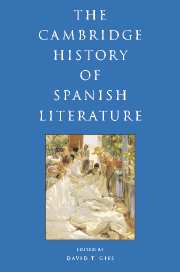Book contents
- Frontmatter
- I INTRODUCTION
- II HISTORY AND CANONICITY
- III THE MEDIEVAL PERIOD
- IV EARLY MODERN SPAIN: RENAISSANCE AND BAROQUE
- V THE ENLIGHTENMENT AND NEOCLASSICISM
- VI THE FORGING OF A NATION: THE NINETEENTH CENTURY
- VII THE MODERN, MODERNISMO, AND THE TURN OF THE CENTURY
- VIII TWENTIETH-CENTURY SPAIN AND THE CIVIL WAR
- IX IN AND OUT OF FRANCO SPAIN
- X POST-FRANCO SPANISH LITERATURE AND FILM
- 52 Spanish literature between the Franco and post-Franco eras
- 53 Post-Franco poetry
- 54 Spanish prose, 1975–2002
- 55 Post-Franco theatre
- 56 Spanish literature and the language of new media
- Bibliography
- Index
- References
55 - Post-Franco theatre
from X - POST-FRANCO SPANISH LITERATURE AND FILM
Published online by Cambridge University Press: 28 March 2008
- Frontmatter
- I INTRODUCTION
- II HISTORY AND CANONICITY
- III THE MEDIEVAL PERIOD
- IV EARLY MODERN SPAIN: RENAISSANCE AND BAROQUE
- V THE ENLIGHTENMENT AND NEOCLASSICISM
- VI THE FORGING OF A NATION: THE NINETEENTH CENTURY
- VII THE MODERN, MODERNISMO, AND THE TURN OF THE CENTURY
- VIII TWENTIETH-CENTURY SPAIN AND THE CIVIL WAR
- IX IN AND OUT OF FRANCO SPAIN
- X POST-FRANCO SPANISH LITERATURE AND FILM
- 52 Spanish literature between the Franco and post-Franco eras
- 53 Post-Franco poetry
- 54 Spanish prose, 1975–2002
- 55 Post-Franco theatre
- 56 Spanish literature and the language of new media
- Bibliography
- Index
- References
Summary
In the multiple realms and layers that comprise the contemporary Spanish theatrical landscape, “crisis” would seem to be the word that most often lingers in the air, as though it were a common mantra, ready to roll off the tongue of so many theatre professionals with such enormous ease, and even enthusiasm, that one is prompted to wonder whether it might indeed be a miracle that the contemporary technological revolution – coupled with perpetual quandaries concerning public and private funding for the arts – had not by now brought an end to the evolution of the oldest of live arts, or, at the very least, an end to drama as we know it.
In 1996, José Ramón Fernández, a playwright based in Madrid, went so far as to underscore the presence of a curious inclination toward self-destruction in the theatre profession in Spain, where grim prognostications and dismal portrayals of the current theatrical panorama are surpassed only by the horrors of Francisco de Goya’s black paintings. In the year 2000, Barcelona playwright/poet Joan Casas (1950–) dared to pose the provocative hypothesis that the often-cited “new Catalan dramaturgy,” in effect, might be merely a “mirage.” (“Dramaturgy,” in Spain, generally refers to the art of writing plays and/or the textual organization and design of the mise en scène.) Furthermore, during the past decade, the tempestuous cultural-political milieu surrounding the construction and reconstruction of several architecturally striking and ostensibly lavish public theatre venues – which include, in Barcelona, the Teatre Nacional de Catalunya, the new Teatre Lliure, and the Gran Teatre del Liceu, and, in Madrid, the Teatro Real, the Teatro Olimpia, and the Teatro María Guerrero (the historic home of Spain’s Centro Dramático Nacional [CDN]) – has spawned a hallucinatory display of melodramatic moments, impassioned accusations, and hysterical outbursts, witnessed both on and off the stage.
- Type
- Chapter
- Information
- The Cambridge History of Spanish Literature , pp. 724 - 738Publisher: Cambridge University PressPrint publication year: 2005



